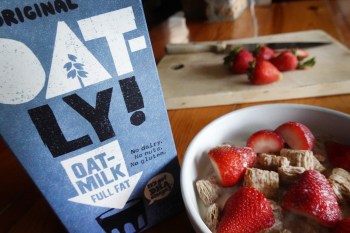Dairy farmers find more green in grass
TEXT OF STORY
BOB MOON: Milk prices are sure easier to swallow these days. Lowest since 1979. Good news for milk drinkers. Not so, if you’re a farmer struggling to stay in business. Last week, the Senate approved a $350-million rescue plan. But dairy producers are still scrambling to save money and Missouri farmers are paying close attention to how New Zealand immigrants feed their cows. From KBIA, Maureen McCollum reports.
MAUREEN MCCOLLUM: Kevin Van der Poel really wanted to expand his dairy business a few years ago. The problem for this New Zealander was that farmland in his country is super expensive. So, he went on a global quest for land. He looked in Australia and Chile. But, van der Poel eventually settled on this farm in southwest Missouri. Land here costs about $2000 an acre, versus $20,000 back in New Zealand.
Kevin Van der Poel: We wanted to find somewhere that grew grass, and we found southwest Missouri was a good place to go.
Van der Poel could now grow exactly the type of grass he needed. Grass that cows eat while roaming open fields. This concept is revolutionary in the U.S. dairy industry. Milk cows here are usually kept in stalls most of the day and fed corn and grains. That setup allows each cow to produce more milk. But, it costs three times as much to feed cows this way.
Here’s why that matters. With the price of milk at its lowest in years, Missouri farmers who keep cows in stalls are losing money. Those with cows grazing in fields are breaking even.
Van der Poel: New Zealand has been very successful with milking cows from pasture, and we wanted to see if we could use some of those skills learned in New Zealand in America.
.
Today, there are 20 New Zealanders on four Missouri farms. And they’re teaming up with the University of Missouri to show struggling local farmers they do have options.
STACEY HAMILTON: Dairymen are losing, they’re bleeding everywhere.
Stacey Hamilton is a dairy specialist with University of Missouri Extension. He lobbied hard for the New Zealanders to come. Hamilton doesn’t think it’s necessarily bad to keep cows in stalls. But his research does show farmers can benefit economically by moving their cows to the pasture. For one, it cuts down on vet bills, because conditions are generally more sanitary.
HAMILTON: In a lot of free-stall operations, the cows get done eating, they get a drink, they walk 10 feet, and lay down in stall and they may be putting their udder in a manure pile.
Hamilton says grazing techniques can also help save farmers a lot of time. Less feeding, less milking. And that’s important because many kids aren’t interested in the long hours of a dairy farmer.
HAMILTON: So they may be milking 8-12 hours a day. That’s why their kids didn’t want to come back, because they never saw their mom and dad. Mom and dad was in the shed the whole time.
Mike Meier understands that feeling. None of his three sons want to take over his dairy farm. Meier himself almost gave up on the business completely. That is until Hamilton and a New Zealand worker from Van der Poel’s farm introduced Meier to the grazing method. The transition allowed him to finally take a hunting vacation last winter.
MIKE MEIER: I was in South Dakota pheasant hunting.
Meier didn’t need to purchase extra land for grazing. He took the area where he used to grow corn and alfalfa for the cows, and started growing grass on it instead. The leftover grass is turned into hay for the cows to eat in the winter.
MEIER: When I start implementing what those guys were showing me, it’s really starting to work now.
Meier wants to purchase even more cows next year.
Back at Kevin Van der Poel’s farm, he watches hundreds of cows line up, waiting patiently for workers to attach milking machines to their udders.
Van der Poel says here’s how he measures success. Some Missouri locals were skeptical when he first arrived with his grazing technique. At first, Van der Poel noticed that conversations at the local cafe would come to a dead stop when he walked through the door. Now, everyone wants to buy him a cup of coffee.
From Harwood, Mo., I’m Maureen McCollum for Marketplace.
There’s a lot happening in the world. Through it all, Marketplace is here for you.
You rely on Marketplace to break down the world’s events and tell you how it affects you in a fact-based, approachable way. We rely on your financial support to keep making that possible.
Your donation today powers the independent journalism that you rely on. For just $5/month, you can help sustain Marketplace so we can keep reporting on the things that matter to you.


















